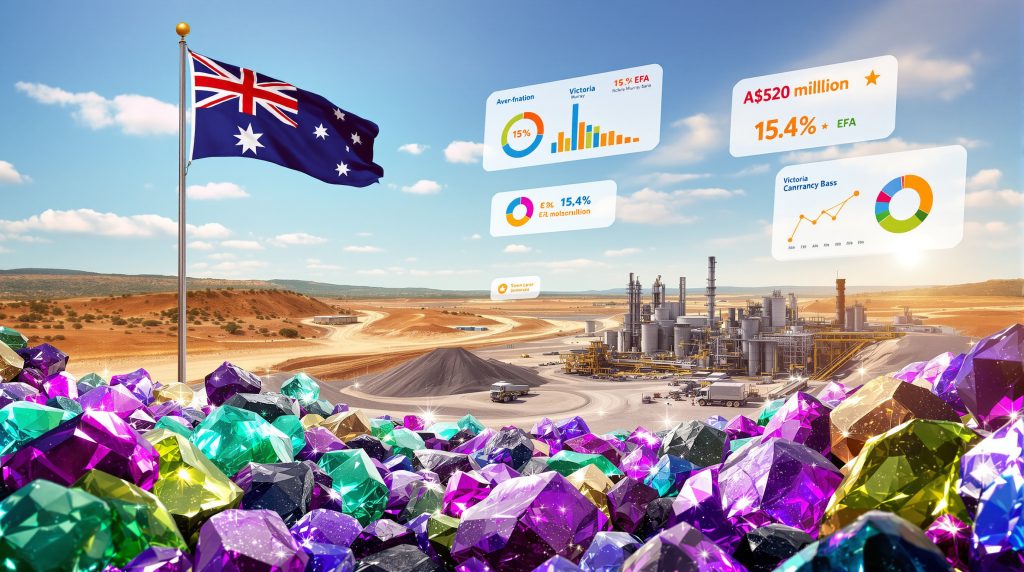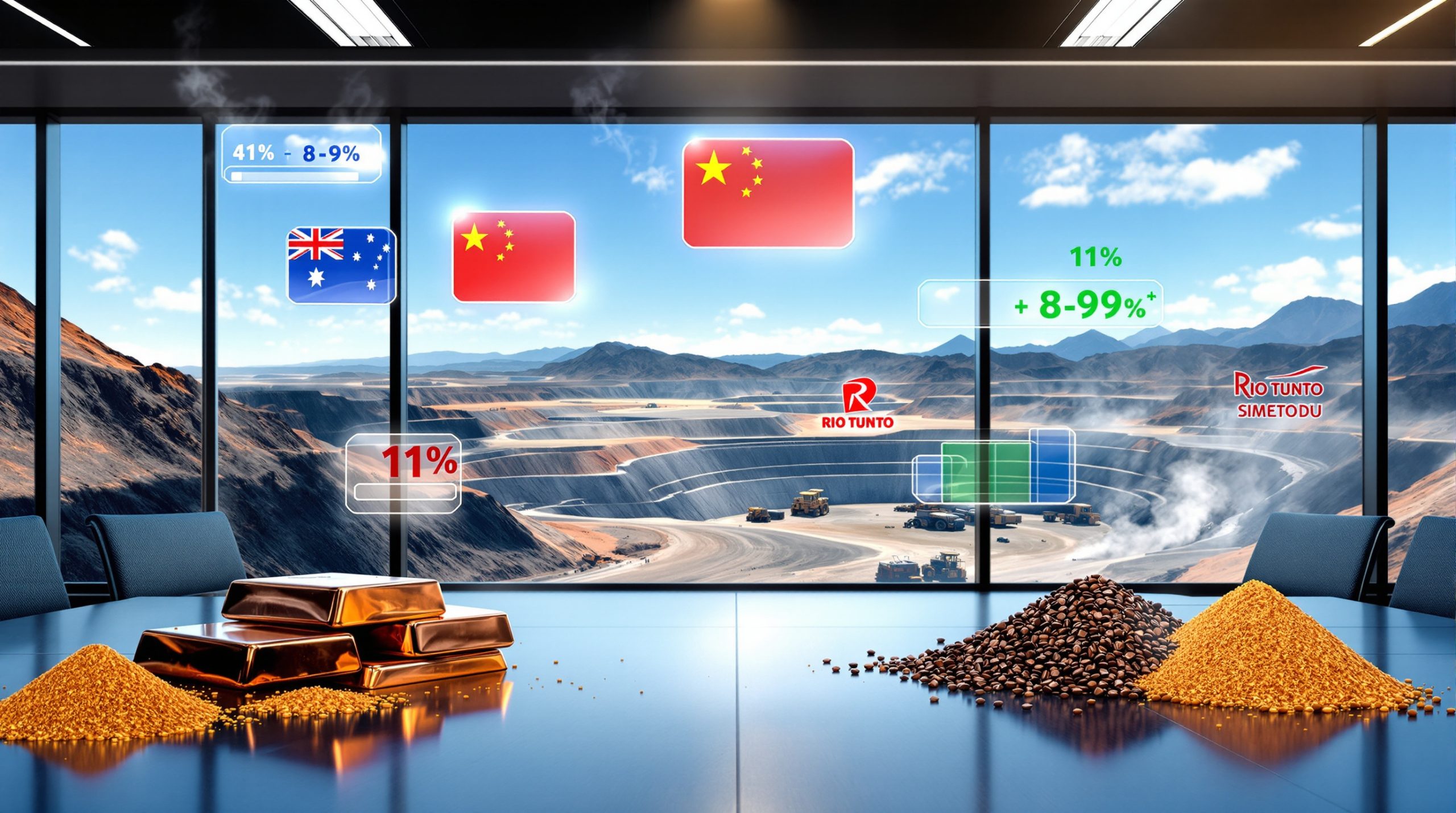Export Finance Australia's Strategic Mining Project Support
Export Finance Australia operates as the nation's official export credit agency, delivering targeted financial solutions that strengthen Australia's position in global trade while supporting critical infrastructure development. The organization has emerged as a crucial player in financing strategically important mining ventures, particularly those that enhance supply chain security for essential minerals and rare earth elements. The recent Donald Project financial support from Export Finance Australia exemplifies this strategic approach to critical mineral development.
The agency's core functions extend beyond traditional lending, encompassing risk mitigation for complex mining developments and facilitating international partnerships that align with Australia's broader economic interests. With total facilities reaching A$7.8 billion as of June 2024, EFA has significantly expanded its exposure to the mining sector, growing from A$1.2 billion in 2020 to A$2.8 billion in 2024.
Primary EFA Capabilities Include:
- Senior and subordinated debt financing for export-oriented projects
- Risk mitigation solutions for complex mining developments
- Strategic support for critical mineral supply chain initiatives
- International trade partnership facilitation
- Working capital and bonding facilities
The agency operates under the Export Finance and Insurance Corporation Act 1991, providing flexibility to support projects that commercial markets may consider too risky but which serve Australia's national interests. This positioning has become increasingly important as governments worldwide recognise critical minerals energy security as strategic assets requiring innovative financing approaches.
Strategic Significance of the Donald Project Financial Support
The Donald Project's conditional approval for A$80 million in senior debt financing from Export Finance Australia reflects the venture's exceptional strategic importance in reshaping global rare earth supply chains. Located in Victoria's Murray Basin near the towns of Minyip and Donald, this joint venture between Energy Fuels and Astron represents a pivotal opportunity to reduce Western dependence on concentrated rare earth sources.
Australia holds approximately 4.2 million tonnes of rare earth oxide reserves, positioning it as the world's sixth-largest holder of these critical materials. However, global production remains heavily concentrated, with China controlling roughly 70% of mine production and over 90% of processing capacity as of 2024. This context makes the Donald Project financial support from Export Finance Australia particularly significant.
Project Financial Structure:
| Component | Amount (A$ Million) | Percentage |
|---|---|---|
| EFA Senior Debt | 80 | 15.4% |
| Energy Fuels Equity | 183 | 35.2% |
| Additional Debt Syndicate | 135 | 26.0% |
| Partner Contributions | 122 | 23.4% |
| Total Project Investment | 520 | 100% |
The project's strategic value extends beyond its A$520 million total investment, as its rare earth concentrate will be processed at Energy Fuels' White Mesa Mill in Utah. This arrangement creates a vertically integrated Western supply chain that directly supports US national security objectives while strengthening allied partnerships.
With the United States importing approximately 74% of its rare earth compounds and metals in 2023, the Donald Project's contribution becomes particularly significant. Furthermore, the timing aligns with the Trump critical minerals order administration's renewed emphasis on critical mineral supply chain independence.
Murray Basin Geological Advantages
The Murray Basin's geological characteristics provide unique advantages for rare earth extraction. This mineral sands province contains significant heavy mineral deposits, including rare earth-bearing monazite that has accumulated over millions of years of weathering and transport processes.
Unlike hard rock rare earth deposits that require energy-intensive mining and processing, the Donald Project's mineral sands can be extracted using established dredging and separation technologies. This approach typically results in lower environmental impact and more predictable extraction costs compared to conventional rare earth mining operations.
Comprehensive Due Diligence and Financing Conditions
Export Finance Australia's conditional support comes with stringent due diligence requirements that reflect both the complexity of modern mining project financing and the strategic nature of critical mineral developments. The agency follows OECD Common Approaches for Officially Supported Export Credits, ensuring comprehensive environmental and social risk assessment.
Key Due Diligence Components:
- Financial viability assessments including detailed cash flow modelling
- Technical feasibility reviews of processing and extraction methods
- Environmental compliance verification under federal and state regulations
- Social impact evaluations including Indigenous consultation requirements
- Legal and regulatory clearance confirmation
- Market analysis and offtake agreement validation
The financing structure targets a 50% debt-to-equity ratio, which represents a more conservative approach than typical mining projects. This reflects both the strategic nature of the development and the emerging market characteristics of heavy rare earth elements.
Energy Fuels has committed to investing A$183 million in equity, structured as A$45 million pre-Final Investment Decision (FID) and A$138 million post-FID. This phased approach allows for risk mitigation while ensuring adequate funding for project completion.
The conditional and non-binding nature of EFA's support emphasises the importance of meeting comprehensive regulatory and technical milestones before accessing government-backed financing.
In addition, the project benefits from broader strategic initiatives such as the Australia critical minerals reserve, which provides additional context for government-backed financing decisions.
Innovative Financing Model Compared to Traditional Mining Finance
The Donald Project's financing approach represents a significant departure from conventional mining project funding, incorporating government-backed export credit alongside private investment to create a more robust capital structure. This model addresses specific challenges associated with critical mineral developments that often face longer payback periods and higher technical risks than traditional commodity projects.
Traditional Mining Finance Characteristics:
- Primary reliance on commercial bank lending at market rates
- Shorter debt tenors (typically 5-7 years)
- Higher interest margins (SOFR/BBSY + 4-7%)
- Focus on established commodity markets
- Limited government involvement beyond standard permitting
Strategic Critical Mineral Financing Features:
- Export credit agency participation providing longer-term capital
- More competitive interest rates (typically SOFR/BBSY + 2-4%)
- Extended debt tenors (7-12 years)
- Government policy alignment considerations
- Supply chain security premium valuations
According to industry analysis, export credit agencies provided approximately 15-20% of global mining project debt in 2023, representing a significant increase from 10-12% in 2020. This trend reflects growing government recognition of critical minerals as strategic national assets requiring specialised financing support.
For instance, the Export Finance Australia's new measures demonstrate the agency's commitment to building the critical minerals sector. Consequently, the Donald Project financial support from Export Finance Australia fits within this broader strategic framework.
The International Energy Agency's 2024 critical minerals outlook highlighted that government-backed financing has become increasingly essential for projects supporting energy transition supply chains, particularly those facing technology development risks or serving strategic rather than purely commercial objectives.
Expected Production Capabilities and Market Impact
Upon reaching full operational capacity, the Donald Project will deliver substantial contributions to global rare earth supply, with particular significance for heavy rare earth elements essential in advanced technology applications. The project's Phase 1 production targets of 7,200 tonnes per annum of rare earth element concentrate (REEC) position it as a meaningful contributor to Western supply chain security.
Detailed Annual Production Breakdown:
- Total REEC Production: 7,200 tonnes per annum
- Neodymium-Praseodymium Oxides: 1,000 tonnes
- Dysprosium Oxide: 92 tonnes
- Terbium Oxide: 16 tonnes
- Additional Light and Heavy REE: Balance of concentrate
To contextualise these production levels, global dysprosium oxide production reached approximately 2,500 tonnes in 2023, while terbium oxide production totalled roughly 450 tonnes. The Donald Project's contributions would represent approximately 3.7% of global dysprosium supply and 3.6% of global terbium production.
Critical Applications and Market Significance
The project's heavy rare earth production addresses specific supply vulnerabilities in critical technology sectors. Dysprosium and terbium are essential for high-performance permanent magnets used in wind turbines, electric vehicle motors, and defence applications.
US Market Coverage Analysis:
| Element | US Annual Demand | Donald Project Supply | Coverage Percentage |
|---|---|---|---|
| Dysprosium Oxide | 150-200 tonnes | 92 tonnes | 46-61% |
| Terbium Oxide | 30-40 tonnes | 16 tonnes | 40-53% |
These coverage percentages demonstrate the project's potential to significantly reduce US dependence on Chinese rare earth sources, particularly for the heavy rare earth elements that are most strategically sensitive and difficult to substitute.
The integration with Energy Fuels' White Mesa Mill in Utah provides additional strategic value, as this facility represents the only conventional uranium mill in the United States that has been adapted for rare earth processing. The mill completed successful demonstration programmes processing monazite sand in 2021-2022, proving its capability to produce separated rare earth carbonates.
Alignment with Australia's Critical Minerals Strategy
Export Finance Australia's support for the Donald Project directly advances Australia's ambitious 2023 Critical Minerals Strategy, which aims to position the nation as a top-5 global producer of critical minerals by 2030. The strategy commits A$500 million through the Critical Minerals Facility and emphasises developing not just mining operations but comprehensive downstream processing capabilities.
However, this initiative extends beyond mining to support the green transition in mining practices across the industry. The timing of EFA's conditional support coincides with enhanced focus on supply chain security and sustainable mining practices.
Strategic Policy Integration Points:
- Supply Chain Diversification: Reducing Western dependence on concentrated rare earth sources
- Allied Partnership Strengthening: Supporting US and European Union technology industries
- Economic Development: Creating high-value mining and processing opportunities domestically
- Technology Advancement: Enabling clean energy transition and defence applications
Australia's strategy identifies rare earth elements among 31 critical minerals essential for modern technologies and clean energy systems. The approach emphasises vertical integration from mining through processing, exemplified by the Donald Project's direct connection to US-based separation capabilities.
Trump Administration Policy Alignment
The current Trump administration has prioritised critical mineral supply chain security through executive actions and Defence Production Act Title III funding programmes. This policy environment has created favourable conditions for projects like Donald that support Western supply chain independence while reducing dependence on Chinese sources.
Key policy elements include streamlined permitting processes for critical mineral projects, enhanced focus on Western Hemisphere supply chain development, and substantial federal investment in domestic processing capabilities. The administration's emphasis on "America First" supply chain policies aligns closely with the Donald Project financial support from Export Finance Australia strategic objectives.
Broader Implications for Australian Mining Finance
The Donald Project's financing structure may establish a precedent for future critical mineral developments, demonstrating how export credit agencies can effectively bridge the gap between commercial viability and strategic national interests. This model addresses specific financing challenges that have historically limited critical mineral project development.
Emerging Financing Trends:
- Enhanced government support for strategically important mineral projects
- Integration of export credit agency funding with commercial debt markets
- Longer-term capital availability for projects serving supply chain security
- Increased focus on downstream processing and value-added manufacturing
Total investment in Australian critical minerals projects reached approximately A$10 billion across 50+ projects in 2023, with over 30 projects at feasibility or development stages requiring combined financing exceeding A$30 billion. The Donald Project's successful financing approach could facilitate access to capital for similar developments.
Moreover, the defense critical materials strategy provides additional context for understanding how projects like Donald fit into broader national security considerations.
EFA's growing exposure to mining and resources has increased from A$1.2 billion in 2020 to A$2.8 billion in 2024, with critical minerals representing an expanding portion of this portfolio. This trend reflects both increased government priority for critical mineral development and growing private sector recognition of strategic value premiums.
Precedent for Similar Projects
Several other Australian critical mineral developments could benefit from similar financing approaches, including Hastings Technology Metals' Yangibana Project, Arafura Resources' Nolans Project, and various lithium developments in Western Australia. The Donald Project's structure provides a template for combining ECA support with commercial financing and strategic offtake arrangements.
Development Challenges and Strategic Opportunities
Despite Export Finance Australia's conditional support representing a significant milestone, the Donald Project faces typical mining development challenges alongside unique opportunities in the evolving critical minerals landscape. Historical data indicates that approximately 20-30% of rare earth projects at feasibility stage proceed to production, with financing gaps representing the primary failure point for 40% of unsuccessful projects.
Primary Development Challenges:
- Completion of remaining due diligence requirements for final EFA approval
- Securing additional commercial debt syndicate partners for the A$135 million balance
- Meeting comprehensive environmental and social compliance standards
- Managing construction timelines to achieve H2 2027 production targets
- Navigating rare earth price volatility during development phase
Current Market Conditions:
- NdPr oxide prices (2024): US$47-52/kg (down from 2022 peak of US$160/kg)
- Dysprosium oxide prices (2024): US$250-280/kg (relatively stable)
- Terbium oxide prices (2024): US$950-1,050/kg (premium maintained)
Strategic Development Opportunities
The project benefits from several unique advantages that position it favourably for successful development. The life-of-mine offtake agreement with Energy Fuels provides revenue certainty, while the established White Mesa Mill processing capability eliminates typical rare earth separation risks and costs.
Key Success Factors:
- Proven mineral sands extraction technology reducing technical risk
- Established processing pathway through White Mesa Mill
- Strong government support from both Australian and US administrations
- Growing demand for heavy rare earths in clean energy applications
- Limited alternative supply sources outside China
The project's development timeline aligns favourably with anticipated growth in electric vehicle and wind energy markets, both of which require substantial quantities of neodymium, praseodymium, dysprosium, and terbium for permanent magnet applications.
Future Expansion Potential
Beyond Phase 1 production levels, the Donald Project offers potential for expansion as market conditions and processing capabilities develop. The Murray Basin contains additional mineral resources that could support extended operations, while Energy Fuels' processing capabilities at White Mesa Mill could potentially accommodate increased throughput.
The success of this financing model could facilitate development of additional critical mineral projects using similar structures, potentially establishing Australia as a reliable alternative to Chinese rare earth dominance while supporting Western technology and defence industries.
Export Finance Australia's conditional support for the Donald Project represents more than traditional project financing – it demonstrates evolving recognition of critical minerals as strategic national assets requiring innovative approaches that balance commercial viability with supply chain security objectives. As global competition for critical mineral access intensifies, such partnerships between government agencies and private developers may become increasingly essential for maintaining Western technological and economic competitiveness.
Looking for the Next Major Critical Minerals Discovery?
Discovery Alert's proprietary Discovery IQ model provides instant notifications when significant ASX mineral discoveries are announced, helping subscribers identify critical minerals opportunities ahead of the broader market. With major developments like the Donald Project highlighting the strategic importance of critical minerals, staying informed about emerging discoveries could position investors to capitalise on Australia's expanding role in global supply chain security.




